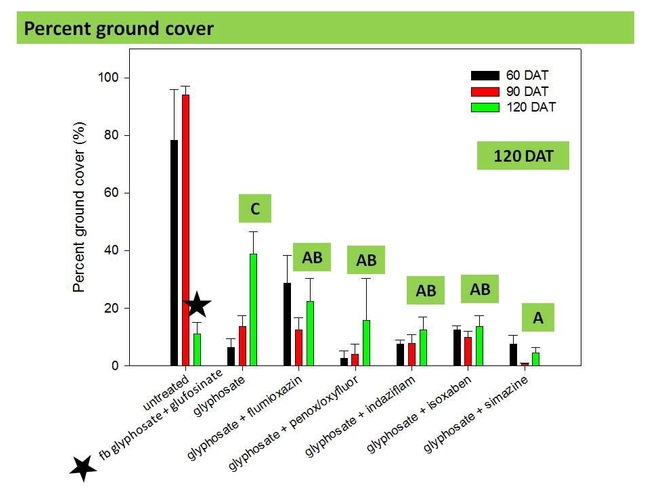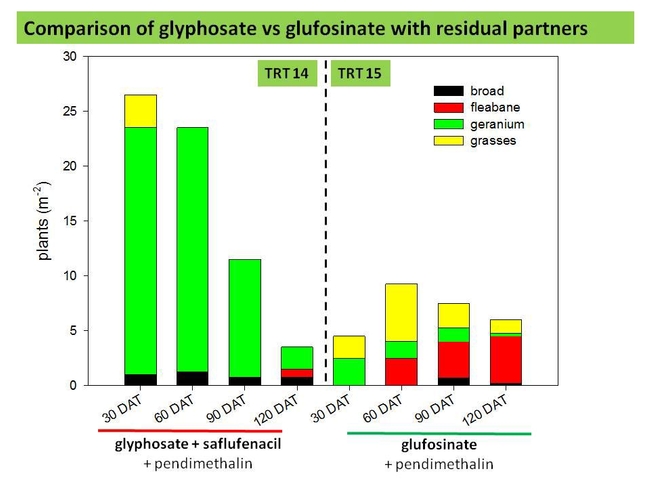Evaluation of pre-emergence herbicides in California almond orchards
by Andrew Johnson, Marcelo Moretti, and Brad Hanson; UC Davis Weed Science (Article originaly posted at UC Weed Science)Several field experiments were conducted to evaluate the performance of pre-emergence herbicides, herbicide rates, and tankmix combinations at different locations in the Central Valley of California and to compare the efficacy of burndown herbicides in mixture with different pre-emergence herbicides. The same treatments were used in three studies located in Fresno, Merced, and Colusa counties. Only data from the Merced county site is presented due to low weed densities at the Fresno and Colusa county sites.The experiment was conducted in a mature almond orchard with solid-set sprinkler irrigation, and very sandy soil (95% sand) near Delhi, CA. Treatments were applied on February 10, 2012 using a CO2 pressurized back pack sprayer delivering 20 GPA with Teejet TTJ02 nozzles. Plots were 40 feet long and 14 feet wide. Weed counts and ground cover estimates were made 30, 60, 90, and 120 days after treatment (DAT). At application, cutleaf geranium (Geranium dissectum), cudweed (Gnaphalium spp.), annual bluegrass (Poa annua), hairy fleabane (Conyza bonariensis) and hare barley (Hordeum murinum) were the most common weed species. Winter weeds in the control plots (treatment 1) were treated with glyphosate + glufosinate 90 days after the initial treatment to allow evaluation of spring germinating weeds. All treatments are presented in Table 1. There were several comparisons that might be of interest as weed management decisions are made for the winter season. A comparison of different residual materials including flumioxazin (Chateau), penoxsulam/oxyfluorfen (Pindar GT), indaziflam (Alion), isoxaben (Trellis) and simazone (Princep) tank mixed with glyphosate revealed that all pre-emergence materials tank mixed with glyphosate provided better overall control than glyphosate alone 120 DAT (Figure 1).Figure 1.
There were several comparisons that might be of interest as weed management decisions are made for the winter season. A comparison of different residual materials including flumioxazin (Chateau), penoxsulam/oxyfluorfen (Pindar GT), indaziflam (Alion), isoxaben (Trellis) and simazone (Princep) tank mixed with glyphosate revealed that all pre-emergence materials tank mixed with glyphosate provided better overall control than glyphosate alone 120 DAT (Figure 1).Figure 1. It is also worth noting that different pre-emergence herbicides varied in their control specific weeds. Knowing what weeds are present can help in selecting a residual material that will effectively control your weed population. Control of individual weeds for all tank mixes at 120 DAT can be found in table 1. For instance among the treatments 1-7 control of hairy fleabane simazine and penoxsulam + oxyfluorfen was significantly better than flumioxazin at 120 days (Figure 2).Figure 2.
It is also worth noting that different pre-emergence herbicides varied in their control specific weeds. Knowing what weeds are present can help in selecting a residual material that will effectively control your weed population. Control of individual weeds for all tank mixes at 120 DAT can be found in table 1. For instance among the treatments 1-7 control of hairy fleabane simazine and penoxsulam + oxyfluorfen was significantly better than flumioxazin at 120 days (Figure 2).Figure 2. While selecting the correct pre-emergence herbicide is important, selecting an effective burn down partner can be equally important. This is becoming especially important for hard to control species like glyphosate-resistant horseweed and fleabane. Again is it important to choose a burn down material that will provide control of your specific weed populations. Treatments containing glufosinate provided the best control of cutleaf geranium when compared to glyphosate and glyphosate + saflufenacil (Figures 3 and 4). Better residual activity is favored by good initial weed control provided by the burn down component of the herbicide tank mix.Figure 3.
While selecting the correct pre-emergence herbicide is important, selecting an effective burn down partner can be equally important. This is becoming especially important for hard to control species like glyphosate-resistant horseweed and fleabane. Again is it important to choose a burn down material that will provide control of your specific weed populations. Treatments containing glufosinate provided the best control of cutleaf geranium when compared to glyphosate and glyphosate + saflufenacil (Figures 3 and 4). Better residual activity is favored by good initial weed control provided by the burn down component of the herbicide tank mix.Figure 3. Figure 4.
Figure 4.
